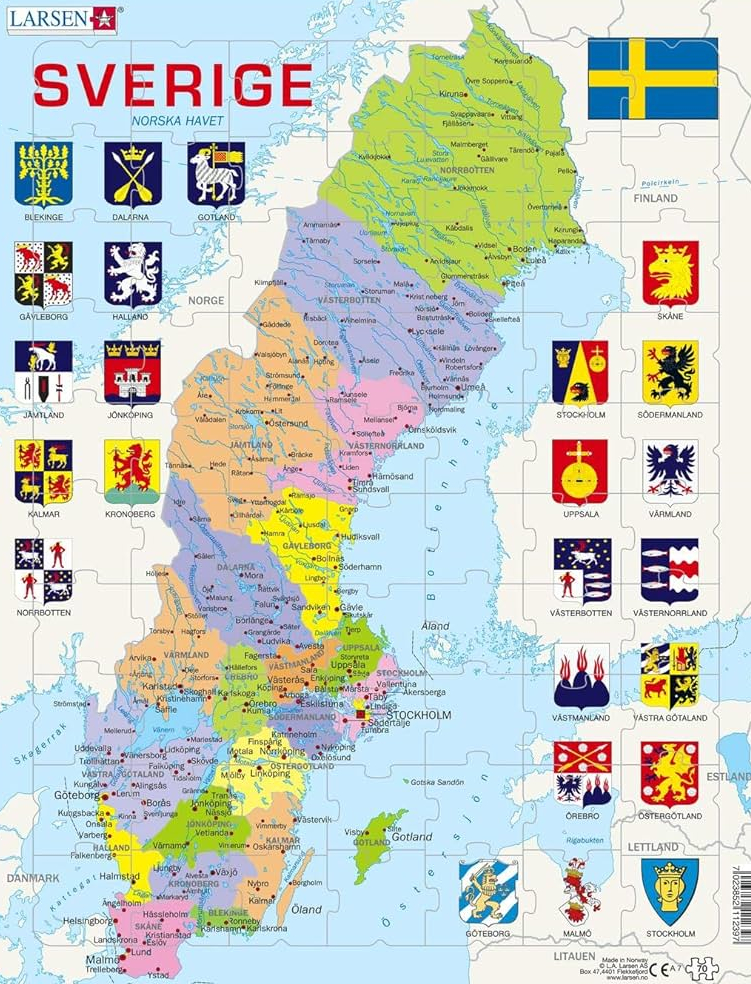
Schwedisch (Eigenbezeichnung: ) gehört zum ostnordischen Zweig der germanischen Sprachen. Damit ist das Schwedische auch Teil der indoeuropäischen Sprachfamilie. Das Schwedische ist eng verwandt mit dem Dänischen und dem Norwegischen (Bokmål, Nynorsk). Wie die anderen nordischen Sprachen stammt es vom Altnordischen ab, das die Sprache der Germanen in Skandinavien war.
瑞典语(![]() svenska 帮助·信息 [ˈsvɛ̂nːska]),中文也称瑞典文,是北日耳曼语(也称为斯堪的那维亚语)的一种,主要使用地区为瑞典、芬兰(尤其是奥兰群岛),使用人数超过九百万人。它和斯堪的那维亚地区另外两种语言——丹麦语和挪威语——是相通语言。和其它北日耳曼语一样,瑞典语来源于古诺尔斯语。古诺尔斯语是维京时期斯堪的那维亚地区通用语言。
svenska 帮助·信息 [ˈsvɛ̂nːska]),中文也称瑞典文,是北日耳曼语(也称为斯堪的那维亚语)的一种,主要使用地区为瑞典、芬兰(尤其是奥兰群岛),使用人数超过九百万人。它和斯堪的那维亚地区另外两种语言——丹麦语和挪威语——是相通语言。和其它北日耳曼语一样,瑞典语来源于古诺尔斯语。古诺尔斯语是维京时期斯堪的那维亚地区通用语言。
瑞典成人的识字率高达99%。标准瑞典语是瑞典官方语言,来源于19世纪瑞典中部的方言,并在20世纪初固定下来。标准瑞典语的口语和书面语是统一且标准化的。如今从一些古老的偏远地区的方言演化下来的其它语言变体依旧存在,部分方言和标准瑞典语在语法和词汇上有很大区别,已经不能称为相同语言。这些方言只在很偏僻的地区使用,并且使用的人数很少,而这些人社会流动性很低。虽然目前没有迹象这些语言将成为死语,有很多学者认真研究这些方言,并且当地政府也鼓励人们使用这些方言,但是自上个世纪以来,使用这些方言的人数还是逐渐减少。
瑞典语标准语序是主谓宾结构,有时为了强调某些词会更改语序。瑞典语的构词学和英语相近,词形变化相对较少;有两种词性,没有语法上的格(以前的研究认为有两种格,主格和属格);单数和复数之间有区别。形容词根据词性、数量和限定范畴的不同发生改变。名词的限定范畴通过不同后缀来表示,同时前面加以定冠词和不定冠词。韵律特征体现在重音和声调上。瑞典语有大量元音。瑞典语还以Sj音而著称,这是一种变化复杂的辅音音位。
スウェーデン語(スウェーデンご、svenska [ˈsvɛnːˈska] (![]() 音声ファイル))は、インド・ヨーロッパ語族ゲルマン語派北ゲルマン語群東スカンジナビア諸語に属する言語である。主にスウェーデンで使用される。
音声ファイル))は、インド・ヨーロッパ語族ゲルマン語派北ゲルマン語群東スカンジナビア諸語に属する言語である。主にスウェーデンで使用される。
長らくスウェーデンに支配されていたフィンランドでも国語としてフィンランド語と併用されている。ただし、公的表記はほとんど両語併記されるが、フィンランドでのスウェーデン語話者(スウェーデン語系フィンランド人)は6%以下である。フィンランド領のオーランド自治州ではスウェーデン語のみが公用語である。
インド・ヨーロッパ語族ゲルマン語派北ゲルマン語群のノルド語の一種に分類されている。同じ古ノルド語にはデンマーク語やノルウェー語も属する。この古ノルド3語の言語は、違いはあるものの非常に近く、それぞれの話者は他の言語をことさら学習していなくてもある程度理解できる。
ウクライナのヘルソン州(クリミア半島の北)にあるGammalsvenskby(「古いスウェーデン語の村」の意)には、エストニア沖の島々からロシア帝国によって18世紀初頭に強制移住させられた人々の子孫が住むが、ウクライナ語やロシア語に押されてスウェーデン語を話す者は減りつつある。
Swedish (Swedish: [ˈsvɛ̂nːska] (![]() listen)) is a North Germanic language spoken natively by 10 million people, predominantly in Sweden (as the sole official language) and in parts of Finland, where it has equal legal standing with Finnish. It is largely mutually intelligible with Norwegian and Danish, although the degree of mutual intelligibility is largely dependent on the dialect and accent of the speaker. Written Norwegian and Danish are usually more easily understood by Swedish speakers than the spoken languages, due to the differences in tone, accent and intonation. Swedish is a descendant of Old Norse, the common language of the Germanic peoples living in Scandinavia during the Viking Era. It has more speakers than any other North Germanic language.
listen)) is a North Germanic language spoken natively by 10 million people, predominantly in Sweden (as the sole official language) and in parts of Finland, where it has equal legal standing with Finnish. It is largely mutually intelligible with Norwegian and Danish, although the degree of mutual intelligibility is largely dependent on the dialect and accent of the speaker. Written Norwegian and Danish are usually more easily understood by Swedish speakers than the spoken languages, due to the differences in tone, accent and intonation. Swedish is a descendant of Old Norse, the common language of the Germanic peoples living in Scandinavia during the Viking Era. It has more speakers than any other North Germanic language.
Standard Swedish, spoken by most Swedes, is the national language that evolved from the Central Swedish dialects in the 19th century and was well established by the beginning of the 20th century. While distinct regional varieties and rural dialects still exist, the written language is uniform and standardized.
The standard word order is, as in most Germanic languages, V2, which means that the finite verb (V) appears in the second position (2) of a declarative main clause. Swedish morphology is similar to English; that is, words have comparatively few inflections. Swedish has two genders[2] and is generally seen to have two grammatical cases – nominative and genitive (except for pronouns that, as in English, also are inflected in the object form) – although it is debated if the genitive in Swedish should be seen as a genitive case or just the nominative plus the so-called genitive s, then seen as a clitic. Swedish has two grammatical numbers – plural and singular. Adjectives have discrete comparative and superlative forms and are also inflected according to gender, number and definiteness. The definiteness of nouns is marked primarily through suffixes (endings), complemented with separate definite and indefinite articles. The prosody features both stress and in most dialects tonal qualities. The language has a comparatively large vowel inventory. Swedish is also notable for the voiceless dorso-palatal velar fricative, a highly variable consonant phoneme.
Swedish has also had historic use in Estonia, although the current status of the Estonian Swedish speakers is almost extinct. Instead, it is used in the Swedish diaspora, most notably in Oslo, Norway, with more than 50,000 resident Swedes.[3]
Le suédois (svenska Écouter) est une langue scandinave parlée par environ 10,4 millions de locuteurs, principalement en Suède et en Finlande, les deux pays dont il est langue officielle. Comme les autres langues scandinaves, il est issu du vieux norrois, la langue commune à tous les peuples germaniques de Scandinavie à l'époque des Vikings. Il reste aujourd'hui mutuellement intelligible avec le danois et le norvégien. La langue écrite et orale est standardisée, mais il subsiste des variantes régionales issues des anciens dialectes ruraux.
Comme la plupart des langues germaniques, le suédois est une langue V2 : le verbe apparaît en deuxième position dans les propositions principales. La morphologie présente un nombre réduit de flexions. Il existe deux genres (commun et neutre) et deux nombres (singulier et pluriel), mais pas de cas. Par défaut, l'article défini est un clitique postposé, mais il existe également des articles séparés. L'adjectif s'accorde avec le nom en genre et en nombre, mais aussi en fonction de son caractère défini ou non. Phonologiquement, le suédois présente un nombre important de voyelles, ainsi qu'une consonne distinctive, le sj, dont la réalisation phonétique exacte varie selon les dialectes et reste débattue.
La lingua svedese () è una lingua germanica settentrionale parlata da 9,6 milioni di persone, prevalentemente in Svezia (come unica lingua ufficiale, dal 1º luglio 2009) ed in alcune zone della Finlandia (circa il 6% della popolazione soprattutto lungo le coste e nelle isole Åland), dove ha pari diritti legali insieme al finlandese. In gran parte è mutuamente intelligibile con il norvegese, mentre minore è l'intelligibilità reciproca con il danese. Discendente del norreno, lo svedese è attualmente la più parlata delle lingue germaniche settentrionali.
Lo svedese standard, parlato dalla maggior parte degli svedesi, è la lingua nazionale evolutasi a partire dai dialetti svedesi centrali nel XIX secolo. Malgrado esistano ancora distinte varietà regionali discendenti dai vecchi dialetti rurali, la lingua parlata e scritta è uniforme e standardizzata.
Alcuni di questi dialetti differiscono considerevolmente dalla lingua standard nella grammatica e nel vocabolario, e non sempre sono mutuamente intelligibili con lo svedese standard. Sebbene non siano in pericolo di un'imminente estinzione, simili dialetti sono stati in declino durante il secolo scorso, nonostante siano ben studiati e il loro uso sia spesso incoraggiato dalle autorità locali.
L'ordine standard delle parole nella frase è Soggetto Verbo Oggetto, sebbene possa essere spesso modificato per sottolineare alcune parole o frasi. La morfologia svedese è simile a quella inglese; le parole subiscono una minima flessione, ci sono due generi grammaticali, c'è distinzione tra singolare e plurale e non ci sono casi (sebbene vecchie analisi postulino due casi, nominativo e genitivo). Gli aggettivi conoscono una costruzione dei gradi di comparazione analoga a quella dell'inglese ma sono anche flessi secondo genere, numero e determinazione. La determinazione dei sostantivi è indicata principalmente attraverso suffissi (uscite), alle quali si affiancano anche alcune forme vere e proprie di articolo. La prosodia evidenzia la presenza sia dell'accento, sia, in molti dialetti, di qualità tonali. Lo svedese è foneticamente interessante anche per la presenza di una fricativa dorsopalatale velare sorda, un fonema consonantico altamente instabile.
El sueco (en sueco: ![]() svenska (?·i)) es una lengua germánica del norte de Europa, hablada por entre 9 y 14 millones de personas. La mayoría de sus hablantes vive en Suecia, en Finlandia y en las Islas Åland (autónomas), donde es el idioma oficial. El sueco es una lengua nórdica, al igual que el danés, el noruego, el islandés y el feroés. Las lenguas nórdicas son un subgrupo de las lenguas germánicas, las cuales forman parte de la familia lingüística conocida como lenguas indoeuropeas. El sueco, al igual que el resto de lenguas nórdicas, desciende del nórdico antiguo, hablado en Escandinavia durante la época vikinga. El sueco es en gran parte comprensible para un noruego y un danés.2
svenska (?·i)) es una lengua germánica del norte de Europa, hablada por entre 9 y 14 millones de personas. La mayoría de sus hablantes vive en Suecia, en Finlandia y en las Islas Åland (autónomas), donde es el idioma oficial. El sueco es una lengua nórdica, al igual que el danés, el noruego, el islandés y el feroés. Las lenguas nórdicas son un subgrupo de las lenguas germánicas, las cuales forman parte de la familia lingüística conocida como lenguas indoeuropeas. El sueco, al igual que el resto de lenguas nórdicas, desciende del nórdico antiguo, hablado en Escandinavia durante la época vikinga. El sueco es en gran parte comprensible para un noruego y un danés.2
El sueco estándar (rikssvenska) es la lengua nacional que evolucionó a partir de los dialectos del centro de Suecia durante el siglo XIX y se estableció completamente a principios del siglo XX. Si bien en la actualidad existen todavía varios dialectos rurales, el idioma hablado y escrito es uniforme y estándar con más del 99 % de habitantes adultos alfabetizados. Algunos de los dialectos genuinos difieren considerablemente del sueco estándar en gramática y vocabulario y no siempre son mutuamente comprensibles con el sueco (por ejemplo, el lenguaje del norte de Dalarna). Estos dialectos están confinados a áreas rurales con poca movilidad social. Si bien no están en peligro de desaparición, las poblaciones que hablan estos dialectos se están reduciendo a pesar de los esfuerzos de las autoridades regionales para preservar su uso.
El sueco se distingue por su prosodia, que difiere considerablemente entre variedades. Esta incluye tanto cualidades de acento como de tono. La existencia de dos tonos lingüísticos es un fenómeno compartido con el idioma noruego estándar, pero no con el danés. El idioma tiene nueve sonidos vocales que se distinguen por su longitud y sus cualidades, con lo que se forman 17 fonemas vocales. El sueco es también notable por la existencia de un fonema dorso-palatal velar fricativo sordo, un sonido que se encuentra en muchos dialectos, incluyendo las formas más prestigiosas del idioma estándar. Aunque similar a otros sonidos con distintas cualidades labiales, hasta ahora no se ha ubicado en otros idiomas; se asemeja parcialmente a una pronunciación simultánea de una sh-inglesa y una j-castellana. En el idioma escrito, este sonido se representa por combinaciones como sk-, skj, stj-, sj- y otras.
Шве́дский язы́к (svenska ) — язык восточной подгруппы скандинавской группы, на котором говорят в Швеции, части Финляндии и на автономных Аландских островах. Самый распространённый язык Скандинавии с числом носителей, превосходящим девять миллионов.




 Hand in Hand
Hand in Hand
 Literature
Literature




